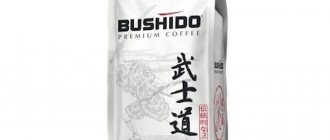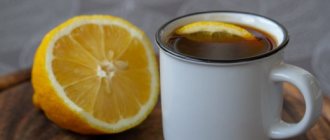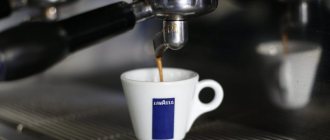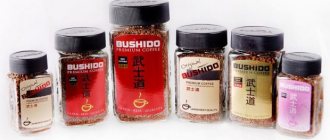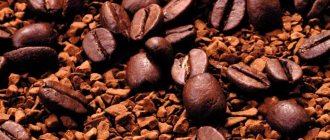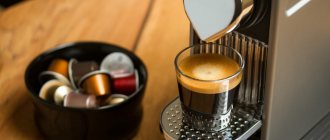On the shelves of supermarkets and coffee shops, customers see the Bushido brand, coffee with an oriental flavor. Appearing in Russia at the beginning of the 21st century, it quickly took pride of place on the menu of domestic coffee lovers.
The concept of a premium Japanese-style drink was developed by one of Germany's leading advertising agencies.
Trademark "Bushido": history and description of the brand
In Japanese, Bushido means “samurai code of honor.” The history of the brand’s creation begins in the Land of the Rising Sun, where coffee was second in popularity to tea. Moreover, instant drinks were not in demand. In the 90s of the last century, enterprising businessmen tried to prepare a light-roasted freeze-dried variety. Consumers liked the new product, but grain and ground varieties began to be sold only 10 years later.
All products called “Bushido” are produced in Switzerland at the HACO Ltd. plant, and masters from Italy work on the blends.
In Russia, the coffee customer is Hors Ltd., which also owns other brands:
- Egoiste;
- Infinity;
- Today;
- Elza;
- "Moskoffee"
The packaging design with hieroglyphs, recognizable among other cans and bags, was developed by the German advertising agency Kakoi. Due to the unusual design, many consumers believe that they bought real coffee from Japan.
You can buy Bushido coffee as Swiss, but don't think it's Japanese.
Origin of the brand
Manufacturers want customers to believe in the Japanese origin of the brand, so they created a legend about some kind of Eastern technology. In fact, the products were developed by the Russian company Hors Ltd, and all production is located in Switzerland.
The packages are marked with the phrase: Japanese highest quality. All information is in English and Japanese, but the Russian translation clarifies that the product is made in Switzerland.
By the way, this company from Russia owns the Egoiste, Elza and other well-known brands. Advertising for Bushido coffee was developed by specialists from Germany, who decided to rely on Eastern philosophy and Western technology.
In addition, Japan has always been famous for the quality of its goods, so buyers do not expect anything bad. The important fact is where Bushido coffee is produced. Switzerland also has a good manufacturing reputation.
Secrets of coffee production
The harvested crop is sorted and the best raw materials are sent to Swiss and Italian factories. There it is manually roasted for 25 minutes over low heat (at about 220°C) in wood-burning ovens and cooled in the fresh air for 10 days.
Roasting is carried out under the supervision of masters who continuously monitor the process.
Varieties of instant Bushido
All categories of Bushido coffee sold belong to the premium segment. There are several types available to buyers.
Red Katana
To produce Bushido Red Katana, Arabica beans of different varieties are used. The place where the raw material grows is East Africa. The prepared drink is strong and tart, moderately bitter.
Consumers note that it is similar to espresso coffee prepared in a coffee machine from ground fruits.
The aftertaste has wine notes. Before roasting, the grain is deep frozen. The finished product is packaged in bright red jars or bags.
Among the taste features of Bushido Red Katana are the presence of wine notes and a long aftertaste.
Black Katana
The crops from the plantations of Central and South America are brought from which the Veracruz mixture is made. It is the main ingredient of this type of coffee with a special taste and aroma. During consumption, an unobtrusive sourness and a slight smell of freshly baked bread and prunes remain in the mouth.
Before cooking, the grains are fried over hot coals, which is why this variety is also called “smoked.”
The finished drink is sometimes confused with the one prepared in Turk and people are surprised when they find out that it is a soluble variety of Bushido. Its packaging or label is black.
The manufacturer roasts coffee beans on hot coals, due to which the product acquires the aroma of campfire smoke.
Light Katana
This variety has a softer, velvety taste, with fruity undertones. For roasting Arabica beans grown on Kilimanjaro plantations in Kenya, a special, gentle regime without high temperatures is used. At the plant where the product is prepared, the mixture for the Katana Light brand is called Kenyvaro by analogy with the country of origin. Her stickers on jars and packaging bags are pink.
Bushido Light Katana instant freeze-dried coffee is good for breakfast.
Original
The birthplace of coffee, the basis of which is the Buenaventura blend, is South America. Its balanced aroma with tart bitterness will appeal to those who like to add a little milk and sugar to the drink. The medium roasting method is called City.
A characteristic feature of Bushido Original is its balanced aroma, as well as the presence of a characteristic bitterness.
Katana Gold 24 carat
The special Bushido variety contains particles of edible gold in the form of additive E 175. Marketers say that Katana Gold coffee prolongs youth, renews and restores the skin. No one has yet undertaken to prove the veracity of this statement, but even critics do not dispute that the drink is not only harmless, but also tasty.
Honey and chocolate flavors give it a spicy kick.
The packaging in the color of noble metal looks expensive, which makes it possible to purchase this variety as a small gift.
Additive E175 is not harmful to health; it has a neutral taste and aroma.
Kodo
This variety is preferred by lovers of the “ground and instant” type of coffee. For production, arabica beans are brought to factories from South America, Tanzania and Ethiopia. The manufacturing technology is called In-Fi.
Granulated coffee particles are encased in a sublimated crystalline shell, making it more like a freshly ground drink brewed in a Turk.
The floral aroma is complemented by a honey-fruity taste and a sweet aftertaste.
Bushido Kodo coffee has a sweet aftertaste and floral aroma.
Types of Bushido instant coffee
The uniqueness of the technology for making instant Bushido lies in the manual roasting of high-quality Arabica varieties. We supply coffee beans that were collected on Brazilian, American, Kenyan, and Asian plantations.
The produced drink does not contain any additives and is recognized as an ecological product. Consumers are offered several types of instant coffee, each of which has a different aftertaste and its own unique aroma:
Red Katana
This drink belongs to the premium class. It is made from a noble Arabica variety. In addition, an African mixture collected from mountain plantations is added for richness of taste. The taste of the drink is rich and rich. It is strong and not very tart at the same time. Packaged in 50 or 100 grams in a glass jar, you can purchase a packaged product. It is quite expensive, about 300-350 rubles. But, according to customer reviews, the price is worthy of the product. Red Katana coffee is used sparingly. After all, to prepare one serving of a strong drink, 0.5 teaspoon is enough.
Black Katana
It is made with a mixture called Vera Cruz, which is openly grilled over charcoal. Comes from American plantations. The uniqueness of the taste - strength, astringency and bitterness are balanced, an unobtrusive sourness with a light mixed bread aroma is felt. Somewhere, a prune taste is vaguely felt in the drink. Analyzing reviews from gourmets, we can safely say that the drink is almost not similar to instant coffee, but rather resembles that prepared in a coffee machine or brewed in a Turkish coffee pot. And yet, it does not lose its taste and aroma after it cools down. You can buy Black Katana coffee at a coffee shop, paying about 200 rubles for a 50-gram jar.
Light Katana
Those who prefer to savor light coffee without adding cream or sugar should try Light Katana. Soluble granules are made from Kilimanjara Arabica. The beans are roasted using a special technology, as a result of which the drink acquires a soft, delicate taste with a velvety tint. After taking a sip, you can feel the fruity notes. The price for a small jar of Light Katana is about 250 rubles.
Original
Original soluble granules are made from grains carefully collected from South American plantations. After assembly, they are fried using a special technology, as a result of which the refinement of aroma and refinement of taste are preserved. Coffee will appeal to those who love a bitter, invigorating drink. The taste and aroma remain even after cooling. A small jar (50 g) costs 260-280 rubles.
Katana Gold 24 carat
Drinking a cup of Katana Gold 24 carats, every gourmet can imagine himself as a god sitting on the top of Olympus. This instant coffee is special, with a unique taste, aroma and composition of the mixture. Made from a very rare Arabica variety that grows on the slopes of Kilimanjaro. The uniqueness is that the finest edible gold is added to the mixture. They say that this is why the drink has magical properties: it is able to rejuvenate cells and prolong life. In Japan, Katana Gold is the most popular coffee. It is aromatic and does not lose this property as it cools. It costs expensive. For a 100-gram glass jar you will have to pay about 1,200 rubles.
Types of ground
in this category :
- Bushido Original is a blend of Robusta and Arabica beans. It has a moderate strength, rich taste, and pleasant sourness. Coffee of this brand is packaged in cans with a capacity of 250 g.
- Bushido Specialty is blended from beans of the same varieties, hand-roasted and naturally cooled. After grinding, the blend is placed in vacuum bags with a special layer and a sealed valve. As a result, a bitter drink with chocolate notes retains its aroma and taste characteristics for as long as possible.
Bushido ground coffee assortment
Bushido also makes great ground coffee. Ground Bushido is produced in tin cans or in special vacuum bags with 250 grams of packaging.
There are two types of Bushido ground coffee – Original and Specialty.
Bushido Original is made from selected robusta and arabica beans. The taste and aroma are rich, but traditional concerns can be forgotten; the drink will not be too strong.
The peculiarity of this type is its deep taste and memorable, unique aftertaste. The coffee has a chocolate flavor with a slight, pleasant bitterness. Has a long and soft aftertaste. The coffee will be stronger, with a greater invigorating effect than the Original.
Which ground coffee is best? You can find our ranking of the best brands here.
Don't know or have doubts about how to use a geyser coffee maker? We'll tell you! The principle of operation is discussed in detail in our article.
This publication will tell you what raff coffee is and how to prepare it.
Instructions for using the Delonghi coffee machine and descaling it are discussed in detail here: https://chay-i-kofe.com/pribory/kofemashiny/instruktsiya-po-primeneniyu-kofemashiny-delonghi-chistka-ot-nakipi/
Assortment of bean coffee
The raw material for coffee beans is hand-roasted Arabica. Small batches of coffee are served over dry heat, which helps preserve the taste, aroma and beneficial properties.
Grand Cru
This variety is supplied to stores not only in grain form, but also ground with the addition of robusta. The harvest is harvested on high mountain plantations, from where it is directly supplied to a Swiss enterprise. The finished drink has caramel and chocolate notes with a long aftertaste.
Specialty
To prepare the blend, raw materials from different harvest years are never used—only grains harvested in the same season are roasted by hand. When tasting coffee, consumers feel a slight bitterness and sourness. For packaging at the factory they use tin cans with a beautiful design.
Bushido Specialty is distinguished by the presence of light bitterness, balanced by sourness.
Wood Roasted Coffee
Mixtures in this category are prepared exclusively in Italy. The fuel for wood stoves is oak, olive and orange wood.
During roasting, grains go through several stages:
- homogenization, or imparting homogeneity to the substances found in the seeds, at a temperature of 60-100°C;
- drying at 100-150°C;
- the Maillard reaction to induce interactions between amino acids and sugar at 150-200°C;
- ripening, which imparts flavor and aroma characteristics at 200-220°C;
- cooling to 20°C.
The secret to the unique taste of coffee is an exceptional combination of roasting phases.
Buyers are offered 3 types of products:
- Bushido Delicato with fruity flavor notes and jasmine aroma. Raw materials from Colombia and Ethiopia are prepared using orange wood.
- Bushido Forte from Tanzania and Kenya on oak logs with flavors of berries, smoke and citrus. The mixture contains only Arabica.
- Bushido Intenso on olive wood. The consumer will smell caramel and hazelnut. His harvest grows in Colombian and Kenyan fields.
All varieties are roasted over medium heat and produced in ground and grain varieties.
Each type of coffee, as well as the wood used, has its own individual roasting schedule.
Ground varieties of the brand
Grain and ground blends are offered to customers as 100% Arabica (high mountain, of course). Specialty series of four varieties and Wood Roasted Coffee, which is made in Italy.
Wood rusted is represented by the following samples:
- Forte is wood-roasted Arabica beans that alter the flavors of Kenyan and Tanzanian beans. The drink turns out more rich and tart. The firewood used is oak.
- Delicato is a softer blend consisting of Colombian and African varieties. Roasting on orange wood is used.
- Intenza - consists of a mixture of Kenyan and Colombian Arabica. Roasted over olive wood.
You can decide which type of ground Bushido coffee tastes best by purchasing trial 100-gram packs.
The packaging is different - in the Italian Bushido coffee series, the product is supplied in airtight paper foil packs.
Criteria and nuances of product selection
It is impossible to give unambiguous recommendations for purchasing Bushido brand products: all of them are of high quality.
But there are a few tips worth heeding:
- You should focus on your own taste and use information from the company’s official website.
- You need to take into account the cost of the product. The more expensive the variety, the higher its organoleptic properties.
- When purchasing, you should look at the cooking method. The difference between instant and natural drinks is quite large.
- The place of production matters. The Italian line differs from the Swiss line in its specific taste.
All reliable information about coffee can be found on the official website of the Bushido company.
Ways to distinguish from a fake
Like any popular product, Bushido coffee is often counterfeited.
To avoid buying counterfeit products, you need to consider that:
- The label must have a hologram in the shape of a coffee bean. When you turn the container, it changes color.
- The original product is packaged only in glass and metal jars, as well as in soft foil bags.
- A plastic container is a 100% sign of a fake.
- Premium segment products cannot be cheap.
- The real Bushido label has a barcode indicating the expiration date, production date and country of origin.
- Some counterfeit manufacturers do not directly counterfeit the drink. They slightly change the colors of the design and some of the letters. Therefore, you need to ensure that the name is spelled correctly.
How to distinguish an original from a fake?
When buying coffee, it is important to focus on some points that can indicate the originality of the selected product. If necessary, you need to contact the seller with a request to show documentation for the products and carefully review the provided certificates.
How to distinguish between fake and original products:
- Real Bushido coffee has a three-dimensional logo in the form of a coffee bean shimmering from different angles.
- The original product must be packaged in a glass jar, paper or waterproof bag. Previously, you could find tin cans. Plastic packaging is a sign of counterfeit.
- It is recommended that you learn to read barcode information. The numbers hide information about the country of origin, company, product, as well as a control digit. All this needs to be compared with what is indicated on the label.
- The title must be spelled correctly. If at least one letter is changed, this is a clear sign of a fake.
- The low price should alert you.
Average cost of coffee
Products under the Bushido brand are sold in large chains, online stores and specialized coffee shops.
Approximate prices for different types of coffee are as follows:
- “Original” instant — 450 rub. per jar 75 g;
- “Red Katana” - 600 rubles. per package 227 g of ground or 100 gram jar of instant;
- Black Katana — 400 rub. for 50 g of instant and 500 rub. for 227 g ground;
- Katana Gold - over 2.5 thousand rubles. per 100 g of instant;
- Light Katana — 600 rub. for a 100 g jar of instant;
- “Kodo” - 650 rub. per 100 g;
- Specialty - 550 rub. for 227 g;
- Wood Roasted Coffee - from 400 to 550 rubles. for 250 g depending on the variety.
Comparative characteristics of the brands “Egoist” and “Bushido”
Both brands are represented in Russia. Coffee is produced at one plant of the Swiss manufacturer HACO Ltd. But some varieties of Egoiste are made in Germany, and Bushido - in Italy. Both mixtures of instant varieties are freeze-dried and 100% natural.
The raw materials for “Egoist” are mainly Arabica beans of African origin. For "Bushido" they also bring robusta. The grains ripen in Africa, Asia, Central and South America.
Some varieties of each brand are fried using a special technology. Egoiste Very Special and Bushido Kodo have In-Fi. The Japanese brand is distinguished by a wide variety of tastes and varieties. It is also more expensive, because... belongs to the elite segment.
The Egoiste and Bushido brands produce high-quality premium coffee.
Interesting Facts
The technology for producing Bushido coffee is carefully protected by manufacturers.
But a few interesting facts are still known:
- all varieties are environmentally friendly and safe food products;
- frying takes place in 25 minutes at 220°C;
- 10 days are allotted for cooling;
- the recipe appeared 300 years ago.
Each of the varieties produced under the Bushido brand will appeal to connoisseurs of real coffee. Despite the high price, the products are in demand among buyers and do not lose popularity over time.
Increasing the cost of goods
The company’s marketing is truly impressive: the focus is on technologies that can be used to withstand competition in the coffee market without violating the law.
What does this mean: Bushido instant coffee is made from grain raw materials, but not elite, as indicated, but regular. The company pays manufacturers in Switzerland and Italy as the best of their kind.
All coffee lovers know that Italians are leaders in the processing and pre-sale preparation of coffee beans. The result is a good product that is in demand.
The advertising that the drink was developed for the Japanese and is their trademark allows the costs to be recouped.
Prices are therefore much higher than what Arabica of this quality would cost. Japan has nothing to do with Bushido coffee - the Japanese themselves completely buy the elite Jamaica Blue Mountain variety for their sales market, so it cannot be bought anywhere - about 10% of the beans of this variety remain for other consumers.
Interesting! Regular grains are used in Japan for taking baths and for pouring tea leaves into swimming pools where people spend their weekends
The Japanese do not drink (very rarely) instant analogues, since the idea of a healthy lifestyle is thriving in the country and people prefer natural products. For them, caffeine is not a drug or a harmful substance. With a daily job of more than 12 hours , surviving without caffeine, much less showing miracles of ingenuity, is almost impossible.
The fact that Japan is the world's third largest supplier of coffee played into the hands of Bushido producers. This means that the industry is thriving in the country and new brands are being released that are worth trying.
